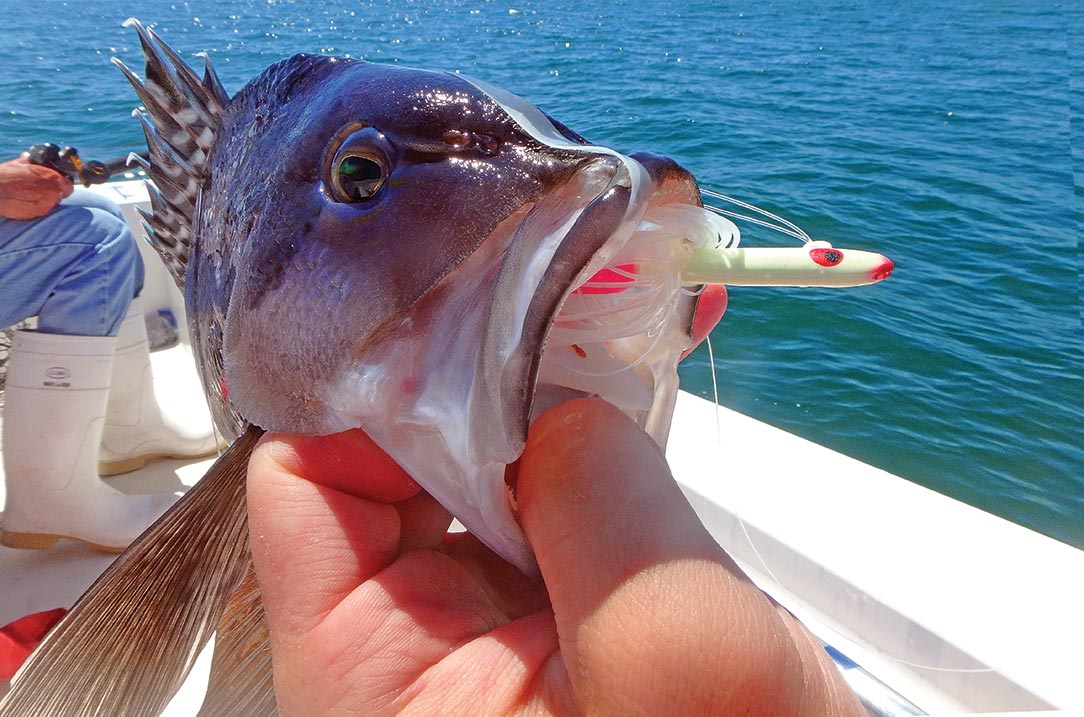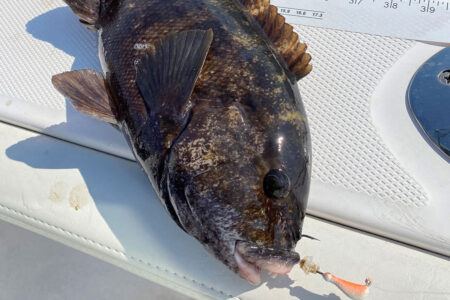Dance that jig-and-teaser to score on fluke, sea bass, scup and more this month and beyond!

While many anglers mark the start of the open-water fishing season as sometime in April based on the opening of such species as winter flounder, blackfish and trout in their local waters, May is when things really get going in our region. The fifth month is when striped bass begin to fill in most places, bluefish begin to pop up (or not) behind schools of squid, and bottom fishing targets like fluke and porgies settle into our bays and inshore waters.
In recent years I’ve seen a noticeable shift in how anglers target inshore bottom fish. When I first got into fishing, it seemed that if you didn’t have a selection of live and/or fresh bait on hand, then you weren’t going to catch as there wasn’t much else available to anglers that would consistently produce. Over the years through innovations in biodegradable artificial alternatives, combined with simple evolution in tactics, any advantage natural baits has all but disappeared. Sure there are those sharpies who employ whole squid or live snapper blues for doormat fluke for example, but plenty of double-digit flatties, jumbo scup and oversized sea bass are duped each year with little more than a jig and teaser adorned with a piece of Gulp. While I wouldn’t go as far as to say one is better than the other, I am confident in saying the playing field is rather level these days and often the advantage goes to the touch of the angler as opposed to the simple freshness of his or her bait.
Keep It Moving
First and foremost, what I’ve learned about jigging for fluke and other bottom-dwellers is to keep things moving. Unless I’m deadsticking a live bait—mummichog, snapper blue or even a fresh-caught squid—success is improved greatly with some extra life added to the presentation. In asking around to some fluke fanatics, I have received a lot of variety as to the proper cadence of the dance for doormats. Some anglers like a slow, steady up-and-down; others prefer sharp, erratic pops; and others still impart steady jigging only comparable to the double-bass of a heavy metal drummer. When I find myself on the fluke grounds I generally employ a bit of each style and cycle through the different actions to see what is or isn’t working for me on a given day. I guess that you could say I have yet to have that magical day where a certain something outperforms the others, so until that day my preference is to stay versatile.
Proper Depth
While there is no arguing that fluke, black sea bass and porgies spend a lot of time on the bottom, they are not exclusively bottom-feeders by any extent. Sure you’re going to find these fish within a few feet of the bottom about 80 to 90 percent of the time, but between fishing experience and observations while free-diving, I have seen all three species feeding from top to bottom in the water column. I’ve even seen our good friend the sea robin taking baitfish off the surface on several occasions, and one evening while walking the beach in search of striped bass I witnessed fluke surface-feeding on schools of peanut bunker as they were corralled in the wash. I will say, however, that for the most part this is the exception to the rule, so if you don’t have the aid of electronics to pinpoint exactly where the fish are holding, then your best bet is to just stay on or near the bottom unless another visual clue tells you otherwise. If nothing else your bait will be more likely to end up in front of the fish’s face that way.

Highs and Lows
Sometimes managing the seasons and bag limits can be difficult, especially in the Northeast where a single drift can pass through multiple state jurisdictions. Keep in mind that you must adhere to the most restrictive regulations in which you will pass through—not just fish—at any time in the trip in which you are in possession of fish. This means that even if a season is open or has a certain bag limit where you launched your boat, but you fish in a state with either a closed season or smaller bag limit, you must abide by that stricter regulation. With that in mind I remind you that ignorance is not an excuse for a fisheries violation, so here are the regulations for Connecticut and New York on sea bass, fluke and scup.
CONNECTICUT
BLACK SEA BASS: May 19 – December 31, 5-fish bag limit, 15-inch minimum. For-hire bonus: September 1 – December 31, 7-fish bag limit.
FLUKE: May 4 to September 30, 4-fish bag limit, 19-inch minimum.
PORGY/SCUP: Private Vessel: January 1 – December 31, 30-fish bag limit, 9-inch minimum. For-hire bonus: September 1 – October 31, 50-fish bag limit.
NEW YORK
BLACK SEA BASS: June 23 –to August 31, 3-fish bag limit. September 1 to December 31, 7-fish bag limit. 15-inch minimum.
FLUKE: May 4 to September 30, 4-fish bag limit, 19-inch minimum.
PORGY/SCUP: January 1 to December 31, 30-fish bag limit, 9-inch minimum. For-hire bonus: September 1 – October 31, 45-fish bag limit.
When fishing jigs for bottom fish, I almost always employ a 2-hook rig of some sort. The basic construction is pretty much the same from one species to the next with a 4- to 5-foot section of 20- to 50-pound leader material attached at the top end to a #4 Spro Power swivel, a surgeon’s loop or snap on the terminal end and a dropper loop tied somewhere in-between. I’ve had just as much success with the dropper kept close to the bottom as I have had with it up to 3 feet up into the water column. I know some fishermen have their specific formula and refrain from much variation, but I have as yet to find a certain measurement that worked all the time so I just tie them where they look right. If, however, I’m not catching at a certain height, or I see a fellow angler doing well, I do not hesitate to change the rigging. Adaptation is the key.
On the terminal end, my choice of snap versus surgeon’s loop really comes down to the size and type of jig I plan on using and how light of a leader is required. So long as the loop is tied large enough, it can fit over most jigs I’m likely to use and is more than sufficient to land your average fluke or sea bass. I also like to forego the snap when I’m fishing shallow water with very light line or when the water is extremely clear (Although I’m not so sure this is as big of an issue as I make it in my mind.). When fishing deeper water with heavier jigs, or when I anticipate changing jigs often, it’s tough to beat the ease of a snap.
Tease ‘Em Up
My old bottom fishing teaser that I used for many years was little more than a slider sleeve rig adorned with bucktail and/or Mylar set above a hook that was tipped with a squid or tinker mackerel strip. This still has its place, but more often than not I either use a single hook with a Gulp Swimming Mullet or a Tsunami Glass Minnow, also tipped with Gulp. I have also used the small 1/4- and 3/8-ounce Spro Prime Bucktails with success as a teaser, especially when specifically targeting fluke. I’m not sure what exactly the attraction here is, but some of my largest fluke have been caught on the tiniest of jigs when fished above a heavy bucktail, fluke ball or diamond jig. You’ll often see reference in the fishing reports throughout the summer of large fluke caught on small bucktails.
Jiggin’ Time

Last on the list is what jig to use, and there are literally thousands of choices here from fancy production jigs to home-brewed concoctions. I generally carry a wide selection of jigs with me including JoeBaggs Tackle Flukies, Spro Prime Bucktails, Berkley Fusion Jigs, Jackpot Diggers, and some homemade stuff I tied up along the way. For colors I have a wide variety from standard white, to traditionally productive pink or chartreuse, to fancy stuff like blue chrome and zucchini. All of them have their day and I have yet to say one is far and away better than the others; well except for maybe white producing on most trips so if you had to go with just one color I’d suggest white. That said, there will be those days when the guy at the rail next to you is slamming the fish on some oddball color and you find yourself scrambling to drum up a bite on white.
The other consideration on the jig is in its weight, and there is no single right answer here. What works off the south side of Block is often different than what works in Long Island Sound or the South Shore bays, so keep a variety on hand and go as light as you can while still staying in contact with the bottom.
So as we enter the summer bottom fishing season, if you’re a holdout on the traditional bait-and-wait approach, perhaps this is the year you make the switch and get jiggy with the rest of us. The odds are pretty good that you’ll put just as many if not more fish on the deck and you’ll spend less time fussing with bait.



